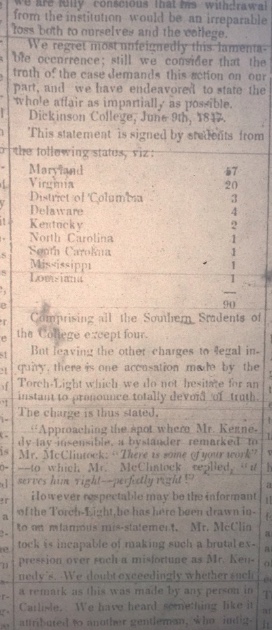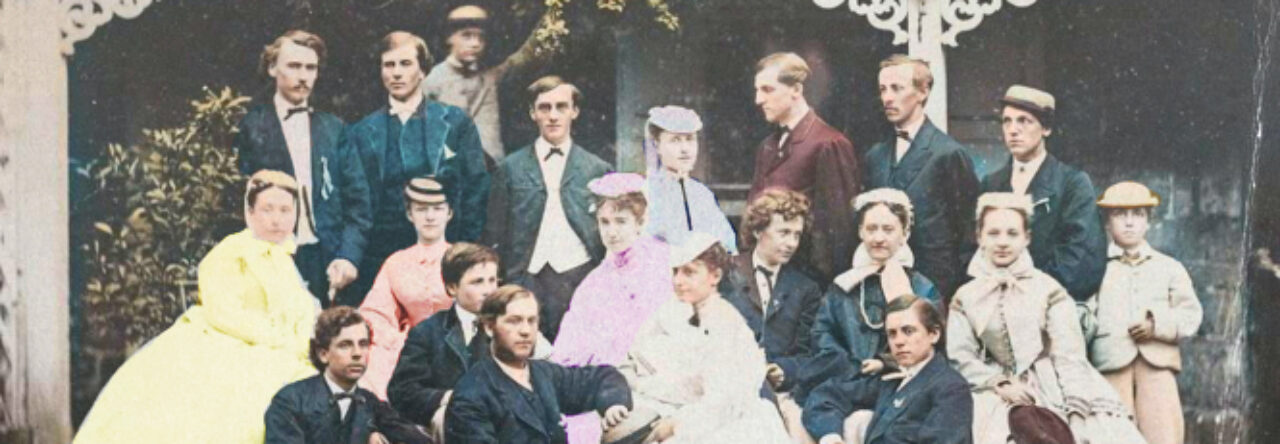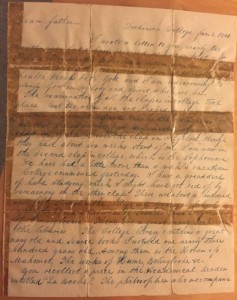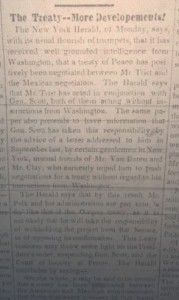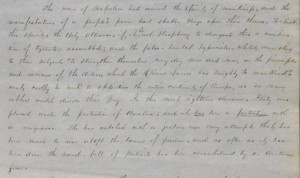While researching members of the class of 1848 I stumbled across an interesting item related to Dr. Henry Martyn Harman. On the Dickinson College Archives website (“archives website”) I found a letter written by Dr. Harman to his father, Andrew Harman under the search results for Henry Harman. This letter gave an eye opening glimpse into college life in the 19th century. In the same file as Dr. Harman’s letter, I found a letter written by Richard N. Edwards to Gilbert Malcolm at Dickinson. This letter explained the reason that Mr. Edwards possessed and sent Dr. Harman’s letter to Dickinson.
My original item was an obituary of Mrs. Anna M. Thomas, wife of Reverend Thomas Snowden Thomas (class of 1848). The obituary, found in the January 29, 1885 issue of The Christian Advocate was interesting in that I learned about her life. Mrs. Thomas was a devoted Methodist who actively tried to work throughout the week in order to rest on the Sabbath. With her husband, she taught her children Christian values even on her death bed.
I lacked interest in this obituary because Mrs. Thomas was not a member of the class of 1848. I decided to research a different item from the archives. That was when I remembered that while researching Dr. Harman, I found a letter that he wrote to his father while at Dickinson in 1846. This was more interesting because Dr. Harman graduated in 1848, and students still write home (actually maybe today we just call and text home).

I decided to transcribe Dr. Harman’s Letter to his father. Even though there was already a transcription in the archives, I thought that it would be good practice for me to transcribe this document. Furthermore, I wanted to compare my transcription with the transcription already in the archives. The sections that are transcribed in bold are transcriptions where I relied on help from the original transcription. The sections that are transcribed in italics are transcriptions where I believe that my transcription was correct and the original transcription was incorrect.
I went farther and transcribed the envelope that carried the letter from Dr. Harman to his father. However, this proved a little more difficult as there appeared to be scribbling that I could not read and scribbling that did not make much sense.
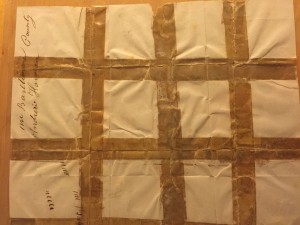
This is a picture of the envelope that held Dr. Harman’s letter. (Archives, photographer-Greg Parker)
The contents of Dr. Harman’s letter were an interesting glimpse into the affairs of a student in the 19th century. Dr. Harman described his academic successes in his freshman year (supposedly the first semester of the 1845-1846 school year). In his freshman year, he took Algebra and Greek. The 1845-1846 college catalogue confirmed that freshman took Algebra and Geometry as part of their Mathematics requirement. The catalogue also confirmed that freshman took Greek and read Xenophon and Homer in that class.
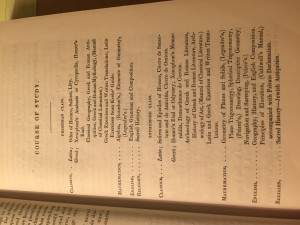
This photo from the 1845-1846 catalogue shows the course load for freshman. (Archives, photographer-Greg Parker)
Interestingly, on the catalogue’s roster of freshman, I found no other names from the 1905 Alumni Record’s roster. That could be because Dr. Harman graduated from Dickinson in three years because he was a freshman in the fall semester of 1845 and a sophomore in the spring semester of 1846. When I looked at the 1847-1848 catalogue, I found many familiar names on the senior roster including John Andrew Jackson Creswell, William Ing, and John Ogden Winner.
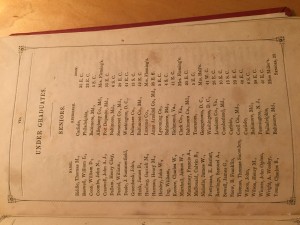
This page from the 1847-1848 catalogue lists the senior class at Dickinson. (Archives, photographer-Greg Parker)
Dr. Harman’s letter was not in great shape. There were strands of tape criss-crossing the page. However, both the letter and the envelope were in protective sheets to preserve them. The letter and envelope were not faded, yet the handwriting was hard to read. Both contents also were complete.
When looking through the file containing Dr. Harman’s letter in the archives, I also found a letter written by Richard N. Edwards, dated 1946. Although dated a century after Dr. Harman’s letter and ninety-eight years after Dr. Harman graduated, this letter was relevant to Dr. Harman’s letter. Mr. Edwards sent this letter with Dr. Harman’s letter to Dickinson in April 1946. In the letter, Mr. Edwards explained the provenance of Dr. Harman’s letter. There was no transcription of Mr. Edwards’ letter at the archives. I took it upon myself to transcribe the letter.
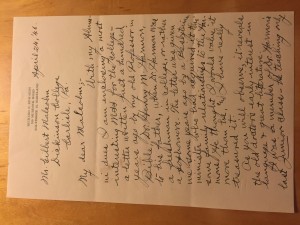
This is the front of the letter that Mr. Edwards sent with Dr. Harman’s letter to Mr. Malcolm. (Archives, photographer-Greg Parker)
Mr. Edwards’ letter was in much better shape than Dr. Harman’s. Maybe it was in better shape because it was a century younger than Dr. Harman’s letter. It was not fragile and it was legible and a little more readable than Dr. Harman’s letter.
Dr. Harman’s letter passed many hands. Dr. Harman’s father kept the letter in his family. Then someone in the Harman family gave the letter to a Presbyterian Minister who had a close relationship with the Harmans. That same minister gave the letter to Mr. Edwards, one of Dr. Harman’s Bible students, with the “thought that [Mr. Edwards] would value it more than he,” and Mr. Edwards claimed that he valued it greatly.
It appeared that Mr. Edwards’ brother, John, also went to Dickinson. After some time researching on the archives website, I found that Mr. Edwards was a member of the class of 1897. I also found that a John Edwards graduated in 1897 too, which contradicted the letter that said John “[was] among [Dr. Harman’s] graduates [in 1896]”. I do not know which source is correct, the archives website or Mr. Edwards’ letter. I hope that the archives website would have correct information about Dickinson alums; likewise, I hope that Mr. Edwards knows the year that his brother graduated.
I could not assume that John and Richard were twins, so I checked Ancestry.com (“ancestry”). The most promising record of John and Richard being related showed Richard Edwards’ birth in England (possible and plausible). It also showed Richard’s birth taking place in 1874, and John’s in 1871. This did not give me all that much confidence that Richard and John Edwards were brothers; however, it proved to be the only Richard Nicholas Edwards result on ancestry that showed a birth in the 1870s with a brother John. Based on this result, Richard was John’s younger brother.
Mr. Richard Edwards’ letter talked about one Bishop Richardson. He said that Bishop Richardson was supposed to come to Dickinson for the commencement in 1946. Based on the archives website, Bishop Ernest Richardson (class of 1896) returned to Dickinson for a thirty-year reunion in 1926, and gave a matriculation sermon in 1927. If Bishop Richardson was at the 1946 commencement, he did not speak at it, otherwise the archives website would say that he delivered a commencement speech in 1946.
I found this archives project very interesting. I learned a lot about college life in the middle of the 19th century. Beyond that, I also learned how to research in the archives and how to transcribe letters that are multiple decades and centuries old.
Bibliography of Archive Items:
Todd, R.W. “Mrs. Anna M. Thomas” in January 29, 1885 issue of The Christian Advocate, Archives and Special Collections, Dickinson College, Carlisle, PA.
Harman, Henry Martyn, to Andrew Harman, Carlisle, 3 January, 1846, Edwards Collection, Archives and Special Collections, Dickinson College, Carlisle, PA.
Edwards, Richard Nicholas, to Gilbert Malcolm, Baltimore, 24 April, 1946, Edwards Collection, Archives and Special Collections, Dickinson College, Carlisle, PA.
Greg Parker

